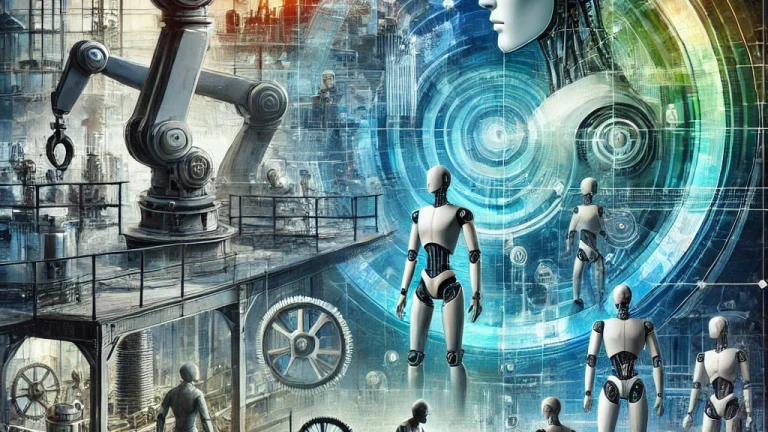
The Evolution of Robotics: From Industrial Automation to Everyday Companions
Introduction: Robotics Through the Ages
Robotics has come a long way from its early days of mechanical automatons to becoming an integral part of modern life. Initially developed to perform repetitive industrial tasks, robots are now evolving into intelligent companions capable of assisting humans in their daily lives. This article explores the journey of robotics, highlighting key milestones, current advancements, and the future possibilities that lie ahead.
The Birth of Robotics: Automation in Industry
The concept of robotics can be traced back to ancient civilizations, but the modern field began taking shape during the Industrial Revolution. Early innovations in mechanical engineering paved the way for machines designed to reduce human labor. However, the true breakthrough came in the 20th century with the advent of industrial automation.
- The First Industrial Robots: In 1961, the Unimate, developed by George Devol and Joseph Engelberger, became the first industrial robot to be used in manufacturing. It revolutionized the automotive industry by automating welding and assembly lines.
- Efficiency and Precision: Industrial robots excelled in performing repetitive tasks with greater precision and efficiency, reducing costs and increasing productivity.
- Expansion Across Industries: Over time, robotics expanded beyond manufacturing into sectors like logistics, healthcare, and aerospace, automating complex processes and enabling advancements that were previously unimaginable.
Robotics in Everyday Life: A Shift Toward Personal Use
While industrial automation laid the foundation for robotics, the 21st century has seen a shift toward personal and service-oriented robots. Innovations in artificial intelligence (AI), machine learning, and sensor technology have enabled robots to interact with humans and adapt to dynamic environments.
- Home Assistants: Devices like the Roomba vacuum cleaner and smart home assistants such as Amazon Alexa and Google Home have brought robotics into millions of households, simplifying chores and improving convenience.
- Healthcare Robots: Robots like the Da Vinci Surgical System assist in performing minimally invasive surgeries, while companion robots like PARO the seal provide emotional support to patients, particularly the elderly.
- Education and Entertainment: Robots like Cozmo and LEGO Mindstorms are designed to teach children coding and problem-solving skills, while humanoid robots like Sophia demonstrate advancements in AI and human-like interactions.
Key Technological Advancements Driving Robotics
Several technological innovations have propelled robotics from industrial machines to intelligent companions:
- Artificial Intelligence and Machine Learning: AI enables robots to process vast amounts of data, learn from their experiences, and make decisions autonomously. This has been crucial in developing robots capable of natural language processing and image recognition.
- Sensors and Actuators: Advances in sensors allow robots to perceive their environment through touch, vision, and sound, while actuators enable precise movements, mimicking human-like dexterity.
- Miniaturization: The miniaturization of components has allowed for the development of smaller, more versatile robots, making them suitable for personal and medical applications.
- Connectivity and IoT: Integration with the Internet of Things (IoT) allows robots to communicate with other devices, creating seamless ecosystems in homes and workplaces.
Challenges in Robotics Development
Despite significant progress, robotics still faces several challenges that need to be addressed to fully unlock its potential:
- Cost: High development and production costs make advanced robots inaccessible to many consumers and businesses.
- Ethical Concerns: The integration of robots into society raises ethical questions about job displacement, privacy, and the potential misuse of AI.
- Complex Environments: Developing robots that can navigate and adapt to unpredictable, real-world environments remains a technical hurdle.
- Regulation and Standardization: The lack of global standards and regulations for robotics creates challenges in ensuring safety and interoperability.
The Future of Robotics: What Lies Ahead?
As technology continues to evolve, the future of robotics holds endless possibilities. Here are some trends and predictions for the next era of robotics:
- Social Robots: Robots designed to interact socially with humans, such as companions for the elderly and assistants for individuals with disabilities, will become more sophisticated and emotionally intelligent.
- Autonomous Vehicles: Self-driving cars, drones, and delivery robots are expected to revolutionize transportation and logistics, making them safer and more efficient.
- Collaborative Robots (Cobots): These robots work alongside humans, assisting in tasks that require both precision and adaptability. Cobots are already being used in industries like manufacturing and healthcare.
- Robotics in Space Exploration: Robots like NASA’s Perseverance rover and humanoid robots like Valkyrie are paving the way for space exploration and colonization.
- AI-Powered Customization: Future robots will leverage AI to adapt to individual user preferences, making them more intuitive and user-friendly.
Conclusion: Robotics as a Partner in Progress
The evolution of robotics reflects humanity’s quest for innovation and efficiency. From industrial automation to everyday companions, robots have transformed the way we live and work. While challenges remain, continued advancements in AI, connectivity, and robotics technology promise a future where robots are not just tools but valuable partners in shaping a better world.
As robotics becomes increasingly integrated into our lives, it is essential to address ethical concerns and ensure equitable access to this transformative technology. By doing so, we can harness the full potential of robotics to improve lives and drive progress across every facet of society.

